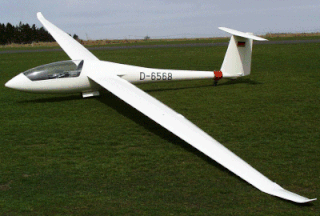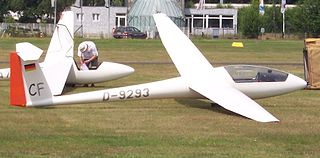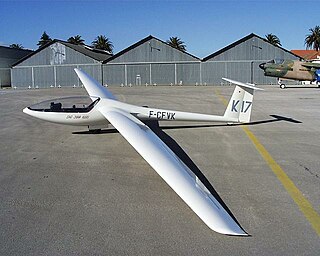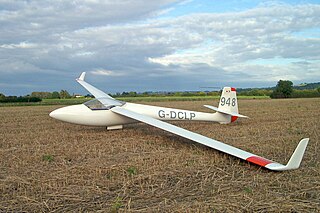
The Schempp-Hirth Ventus is a sailplane produced during 1980–1994 by Schempp-Hirth, a German sailplane manufacturer. It was designed by Klaus Holighaus and replaced the Schempp-Hirth Mini-Nimbus. Schempp-Hirth manufactured 613 Ventus sailplanes.

The Rolladen-Schneider LS7 is a high-performance Standard Class single-seat sailplane produced by Rolladen-Schneider Flugzeugbau GmbH from 1988 to 1993.

The Rolladen-Schneider LS3 is a 15 metre single-seat glider produced by Rolladen-Schneider from 1976 to 1983.

The LS11 or AFK1 is a prototype Two-Seater Class sailplane currently in development at Akaflieg Köln e.V.. The LS11 first flew on 5 November 2005.

The Rolladen-Schneider LS4 is a Standard Class single seat glider manufactured by Rolladen-Schneider Flugzeugbau GmbH between 1980 and 2003.

The Rolladen-Schneider LS1 is a Standard Class single-seat glider manufactured in Germany by Rolladen-Schneider from 1968 to 1977.

The Standard Cirrus is a Standard-class glider built in Germany by Schempp-Hirth. The Standard Cirrus was produced between 1969 and 1985, when it was replaced by the Discus. Over 800 examples were built, making it one of the most successful early fibreglass glider designs.

The Rolladen-Schneider LS8 is a Standard and 18 metre class single-seat glider developed by Rolladen-Schneider and in series production since 1995. Currently it is manufactured by DG Flugzeugbau.

The Rolladen-Schneider LS9 is an 18 metre single-seat motor glider launched in 2000 by Rolladen-Schneider. Production ended after just 10 gliders were built, when Rolladen-Schneider went into receivership.

The ASW 28 is a Standard Class glider with a fifteen-metre span built of modern fibre reinforced composites. The manufacturer of the ASW-28 is Alexander Schleicher GmbH & Co. The 'W' indicates this is a design of the influential and prolific German designer Gerhard Waibel. Serial production started in 2000.

The Glaser-Dirks DG-300 is a Standard Class single-seat high-performance glider built from glass-reinforced plastic. The DG-300 was designed by Wilhelm Dirks and manufactured by Glaser-Dirks Flugzeugbau's Slovenian partner company Elan (company). A total of 511 of all versions were built since production started in 1983. Representative contemporary types from competing manufacturers are the Rolladen-Schneider LS4 and the Schempp-Hirth Discus.
The Rolladen-Schneider LS10 is an 18 metre sailplane designed in Germany by Rolladen-Schneider. A prototype flew in 2003.

The ASW 27 is a 15 metre Class glider built of modern fibre reinforced composites, which first flew in 1995 and was certified in 1997. The manufacturer of the ASW 27 is Alexander Schleicher GmbH & Co. The "W" indicates this is a design of the influential and prolific German designer Gerhard Waibel.

The Glasflügel 201 Standard Libelle is an early composite Standard Class single-seat sailplane produced by Glasflügel from 1967.

The ASW 19 is a single-seat glider built by Alexander Schleicher GmbH & Co, first flying in 1975. It was originally designed as a Standard Class glider, but now mainly competes in the Club Class. The ASW 19 is known for its pleasant handling and some clubs use it as a training glider. It was succeeded by the all-new Schleicher ASW 24.

The Grob G104 Speed Astir was a competition sailplane produced in Germany in the late 1970s as Grob's first design in the 15 metre class.

The Akaflieg Berlin B12 is a high performance two-place glider aircraft that was designed and built in Germany. Conceived as a research vehicle, only one unit was constructed.
The Akaflieg Darmstadt D-40 is an experimental variable geometry single seat sailplane, fitted with almost full span, camber changing flaps for optimum aerodynamics in weak thermals and integrated into the wing so as to minimise flap tip drag. One flew successfully but the D-40, like other variable geometry sailplanes, was not commercialised.

The SZD-42 Jantar 2 is a single seat Open Class competition glider, designed and produced in Poland in the 1970s. It features a span of over 20 m (66 ft) and elastic, camber changing flaps. It was placed second, third and seventh at the 1976 World Gliding Championships. Over one hundred were built and more than ninety remain registered.

The Akaflieg Braunschweig SB 14 is an 18 m (59 ft) Open-class sailplane designed and built in Germany in the early 2000s.


















